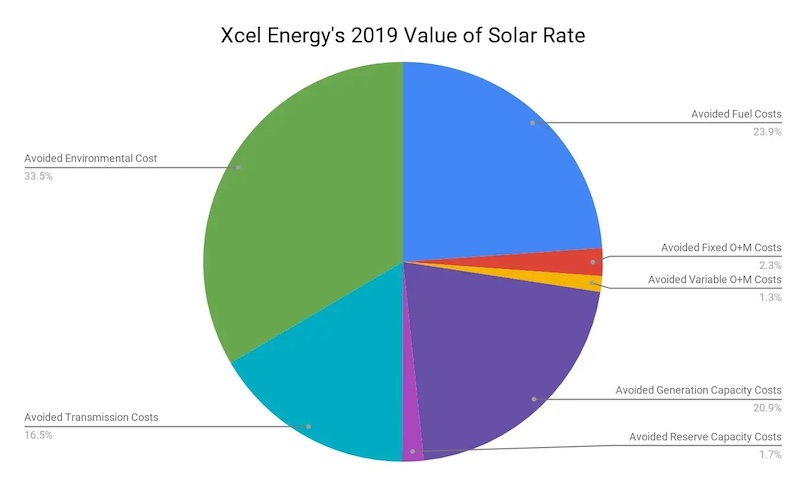Updated 11 months ago
Is Minnesota's Value of Solar tariff the future of solar?
Written by
Catherine Lane

Find out what solar panels cost in your area
Utilities and solar customers throughout the US are at odds over the best way to value homeowners’ solar energy generation.
Utilities often argue that they lose money under net energy metering and lobbying by these utilities has led some states to price solar generation at the much lower avoided cost rate.
Meanwhile, many customers think that the avoided cost rate is not a fair price. They attest that homeowners should earn back the full retail rate in order to help them recoup their investment and to encourage the adoption of home solar.
Introducing the Value of Solar tariff
Value of Solar tariffs are designed to more accurately compensate solar customers by carefully calculating the benefits of solar energy production. Minnesota is the only state to have a set statewide Value of Solar tariff in place.
However, recent Value of Solar price projections for 2020 have upset Minnesota’s largest utility, Xcel Energy; prompting Xcel to ask for changes to the ‘Value of Solar’ formula.
Although the Value of Solar tariff is only mandatory for Minnesota’s community solar projects, its success could lead to the state’s utilities instituting it for their residential customers, as well. This would save Minnesota solar customers much more money as compared to how much they save now.
The rest of the US is looking to Minnesota as an example for Value of Solar tariffs, and whatever changes they make to their tariff could impact how Value of Solar rates are designed throughout the country.
The argument against net metering
Net metering is a widely-used billing method that allows solar homeowners to recover their energy usage costs through their systems’ solar energy production. Homeowners receive a credit that is equal to the full retail rate of electricity in exchange for the energy their solar panels produce.
In places where net metering is offered, solar homeowners can use their net metering credits in order to reduce the amount in which they have to pay toward their electricity bills. Because this reduces the utility’s revenues, utilities feel they are forced to raise electricity rates for their non-solar customers.
Reports have shown that electric rates will increase for non-solar customers as more solar is installed; significant price hikes will occur when solar panel systems make up 10% of the electric grid.
What is the purpose of the Value of Solar tariff?

Community solar farms, such as the one pictured above, are most impacted by Minnesota's Value of Solar tariff.
Minnesota is a long way away from having so many solar installations that it causes rates to increase. Despite this, the Minnesota Public Utilities Commission (MPUC) has taken measures to prevent general rate increases for electricity consumers by creating Value of Solar tariff guidelines.
Value of Solar tariffs are used in the hopes that distributed solar generation will be more accurately compensated for, by taking into account the benefits of solar on the grid. The MPUC guideline outlines how to calculate the ways in which solar provides value to society, as well as the benefits of renewable energy on the grid.
Under the Value of Solar tariff, solar customers pay for all of the energy their home uses at the retail rate of electricity. They are then given a credit for each kilowatt hour (kWh) of energy their solar system produces.
So, if your home uses 30 kWh of electricity in a day and your solar system produces 20 kWh during that same day, you would pay the full retail rate for 30 kWh and get compensated at the Value of Solar rate for 20 kWh.
The Value of Solar tariff is only mandatory for Minnesota’s community solar projects. However, utilities can apply through MPUC to use a Value of Solar tariff as an alternative to net metering. No utilities have applied for this yet.
How is Minnesota's Value of Solar rate determined?
In 2014, Minnesota’s Public Utilities Commission approved the Minnesota Department Of Commerce’s (MDOC) Value of Solar calculation methodology.
Calculating MDOC’s Value of Solar tariff is based on the following 8 variables:
Avoided Generation Capacity Costs
Assumes that solar will prevent utilities from having to build new power plants;
Avoided Transmission Capacity Costs
Estimates how much a utility will save on transmission costs when a customer installs solar;
Avoided Fuel Costs
Determines how much a utility would save in fuel costs over the course of 25 years. This assumes the price of fuel does not fluctuate over time;
Avoided Environmental Costs
The value of how much pollution is offset by installing a solar panel system, including carbon dioxide and non-carbon dioxide pollutants;
Avoided Distributed Capacity Costs
Considers how much money solar installations save utilities by preventing utilities from having to make distribution upgrades, like installing new transmission lines;
Avoided Variable Plant Operations and Maintenance Costs
Estimates how much a utility saves on operations and maintenance costs that are affected by the amount of energy a power plants creates;
Avoided Fixed Plant Operations and Maintenance Costs
Estimates how much a utility saves on annual costs that don’t depend on how much energy a power plant is generating. This includes costs like regular annual power plant maintenance; and
Avoided Reserve Capacity Costs
Assumes that solar projects will increase grid reliability by decreasing solar owners’ reliance on the grid.
Each of the above variables is calculated by using the methods outlined in the MDOC’s guidelines. The result of the variable calculations are then added to find the total Value of Solar rate.
How much can you save with the Value of Solar tariff in Minnesota?
Even though Value of Solar rates don’t provide as much in savings as full retail net metering, they are more valuable than the avoided cost rate. Xcel Energy, Minnesota’s largest utility, does not offer full retail net metering.
Currently, Xcel’s residential customers receive a rate of $0.07139 per kWh of excess generation their solar systems produce. Whereas, in 2019, the Value of Solar rate is $0.1109 per kWh.

Let’s say in one month, your home consumes 1,000 kWh of electricity and your rooftop solar system produces 700 kWh. Under Xcel Energy’s rate of $0.07139, you would save around $49.97 on your electric bill. With the Value of Solar tariff, you would save $77.63. You would have about 35% more in bill savings under a Value of Solar tariff.
The savings are substantially higher with Value of Solar as compared to the avoided cost rate, and such is the case for many places that are currently being billed at the avoided cost rate.
What this means is, your utility switching to a Value of Solar tariff could work in your favor!
What could the future hold for Value of Solar?
Value of Solar tariffs are still a relatively new concept. In fact, Minnesota is one of only two states with an active Value of Solar program in place. But, it is only available to Minnesota community solar customers. Depending on how successful the tariff is for their community solar program, Xcel could possibly extend it to their residential customers.
One Texas utility, Austin Energy, has implemented the only other Value of Solar tariff in the US to its residential customers.
It’s hard to determine how well Value of Solar tariffs actually represent the benefits of solar because there are so few in use. Some have criticized Minnesota’s Value of Solar tariff because they believe the environmental benefits are actually undervalued.
As Minnesota's Value of Solar methodology evolves, we could see Xcel extend the rate to its residential customers. As tensions rise between utilities and solar customers, the country may see more Value of Solar tariffs being implemented.
Catherine has been researching and reporting on the solar industry for five years and is the Written Content Manager at SolarReviews. She leads a dynamic team in producing informative and engaging content on residential solar to help homeowners make informed decisions about investing in solar panels. Catherine’s expertise has garnered attention from leading industry publications, with her work being featured in Solar Today Magazine and Solar ...
Learn more about Catherine Lane